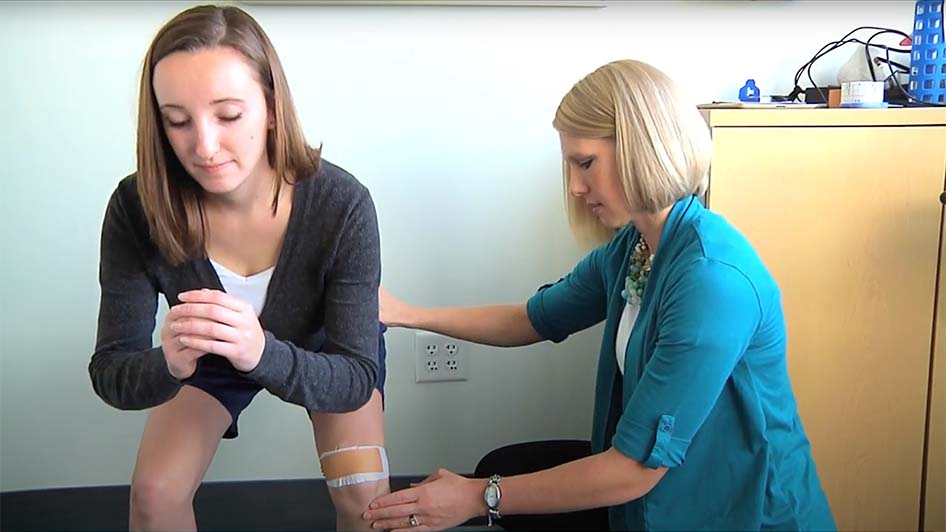Patellofemoral Program
Patellofemoral pain syndrome treatment
Patellofemoral pain syndrome refers to knee pain and instability that can make everything from running down the field to climbing stairs a challenge. The unique approach we take in our Patellofemoral Program can help you finally find relief from your
Our expert team of orthopedists and physical therapists provides a unique and collaborative approach. Each brings their special expertise so we can identify and treat the specific causes of your chronic knee pain. With our program, you’ll see both specialists during each visit, often at the same time, so they can combine their expertise to create a personalized treatment plan for you.
This approach is highly successful, and it has helped hundreds of people move comfortably after long struggles with knee issues. Patients travel to TRIA from across the country to get the specialized care only we can provide.
Whether you’re an athlete looking to get back in the game or someone who needs help with chronic knee pain and instability, we can help.
What is patellofemoral pain syndrome?
Patellofemoral pain syndrome refers to a group of conditions that affect the kneecap (patella). This syndrome primarily affects athletes, especially those who participate in activities that involve running and jumping, which is why you might hear patellofemoral pain syndrome called runner’s knee or jumper’s knee.
Symptoms of patellofemoral pain syndrome include:
- Dull/aching pain around the kneecap
- Decreased range of motion in the knee
- Cracking or grinding sound when moving the knee
- Slight swelling around the kneecap
- Knee pain that increases with activity and when the knee is fully flexed
How our Patellofemoral Program works
Our program is so effective because our physical therapists and orthopedists work in close collaboration to treat your knee pain. By working together, our specialists use their shared knowledge, experiences and expertise to create a highly specialized approach to treating patellofemoral pain syndrome.
During each visit to the clinic you can expect to see both specialists, often at the same time. This helps ensure that we address all of our patient’s needs within the program.
We’ll pinpoint the cause of your knee pain, create a treatment plan for you and use specialized treatments that build strength even with the most complex patellofemoral conditions. Here’s what you can expect:
Patellofemoral pain evaluation
The first step in our program is a thorough evaluation of the pain in your kneecap. One of our physical therapists will perform a joint assessment and check the strength, flexibility, range of motion and positioning of your kneecap.
We might ask you to squat, step up or down, and do other functional activities so we can assess your pain as you move. We’ll also test how treatments like taping the kneecap affect your pain levels.
After your evaluation, we’ll discuss your diagnosis and, together, we’ll develop a personalized treatment plan.
Specialized patellofemoral pain syndrome treatment
Once we’ve evaluated your knee pain, we’ll guide you through your treatment plan. For those patients that travel a long distance to see us, we will work with physical therapists and doctors in your area to make sure everyone is on the same page about the care you need. Your personal treatment plan may include:
Physical therapy
Manual therapy
Manual therapy can help reduce inflammation and pain in and around the knee. We’ll use soft-tissue techniques that are scientifically proven to relieve pain and provide health benefits.
Kinesio taping
Kinesio taping, also called patellar taping or knee taping, can improve knee stability and help reduce pain. We’ll use different taping techniques to see how to best support your kneecap.
Return to sport evaluation
If you’re returning to sports, we’ll work with you to evaluate your function and mobility. Our
Research and continuing education
Our doctors are leaders in treating patellofemoral pain, making them highly sought after as speakers and educators on the topic. We travel around the country sharing our knowledge to give more patients access to this level of treatment for patellofemoral conditions.
In addition, our team participates in many continuing education and research efforts, including observing surgeries and attending seminars. We continuously research treatments and patient outcomes to improve our level of care for our patients. And, our recent studies include how new approaches to treatment improve patellar stability and ACL function.
Visit the

